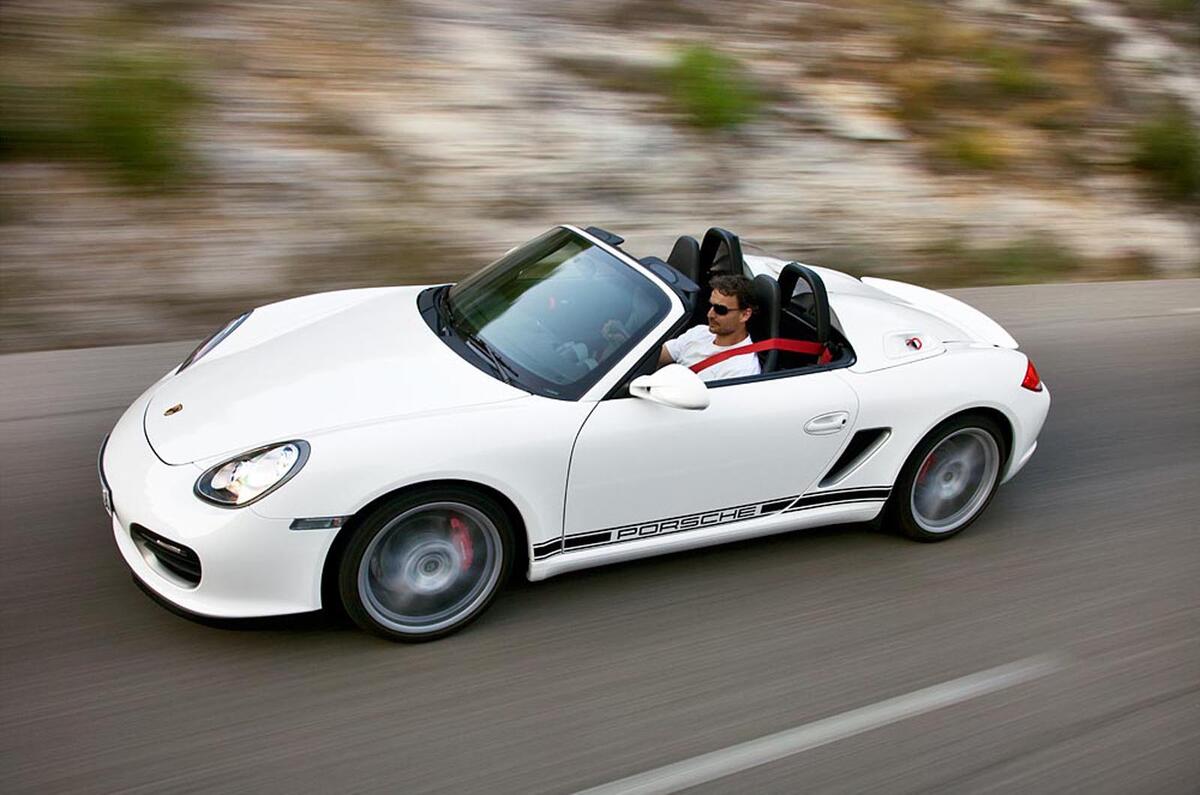What is it?
Drive a standard Porsche Boxster S and you’re unlikely to think, “What this car really needs is less weight and more power.” That’s because the Boxster is about as complete as sports roadsters get.
But somebody at Porsche clearly saw the potential to do just that, and so here is the Boxster Spyder. By using various weight saving techniques including aluminium door panels and engine cover, Porsche has shaved off 80kg and to complete the experience the Spyder gets 10bhp more power and firmer, 20mm lowered suspension than its stable mate.
What’s it like?
Despite the more hardcore nature of the Spyder, it’s no less usable on British roads.
The damping is supple enough to prevent breaks in the surface from unsettling the car or causing any jarring, which helps with comfort as well as keeping the tyres in contact with the asphalt.
That’s not to say that some of the very severe potholes and eroding road surfaces don’t cause some bone-shaking if you tackle them in the Spyder, but in general use over a reasonable British B-road, few other sports cars manage to offer such a well judged blend of body control and damping.
Needless to say, the familiar 3.4-litre boxer engine is a delight. Power is easily accessed thanks to a linear delivery from the naturally aspirated engine, although you’ll have to climb a long way up the rev range – 7200rpm – before you find the 320bhp peak.
If there is any criticism about the handling, it’s that the chassis feels like it could cope with a lot more power. Even so, the Spyder comes close to perfection if you’re after a car that has the immediate responses and outright pace required of a track car but with plenty of on-road usability, too.
Turn-in is very sharp and mid-corner adjustments can be made swiftly and without drama. Plentiful grip also makes the car’s performance easy to plunder, although a smaller steering wheel might be welcome for circuit work.
Even motorway driving is relatively painless. Provided you don’t mind a lot of wind noise battering through the canvas two-piece roof and you’re happy to live without such comforts as a radio and air conditioning (they are available as options), the refined engine, ride quality and comfortable cabin make the Boxster easy to live with over long stretches of motorway.
This is the real joy of the Spyder; you get the extra drama of the Carrera GT looks, the more immediate responses of a truly focused performance car and a healthy dose of the usability for which Porsches are known.
Should I buy one?
The difficulty is that there are still compromises that many will find hard to justify. With prices starting at £46,387, it costs almost £4k more than a standard Boxster S, which has a much more practical electric folding roof and similarly engaging (if less immediate) handling and performance. That canvas hood really is a lot of hassle to remove and replace, and it restricts visibility.
The Spyder would be easier than a Lotus Elise to live with every day, mainly thanks to the better refinement and more spacious cabin, but realistically it’s likely to be a second car that’s reserved for fair-weather driving, and not a cheap one at that. Still, for one of the best-handling cars in the Porsche’s stable, some would consider it a bargain. If you fall into that bracket, don’t hesitate. You won’t be disappointed.

































Join the debate
Add your comment
Re: Porsche Boxster Spyder
How does one open the doors from the inside of the vehicle? What is the purpose of the red loops on the door?
More importantly, why complicate the simple? I cannot believe the door opening mechanism can be that weighty...
Re: Porsche Boxster Spyder
They have manage this trick for years i.e sell a lightweigh special for more than the base model.
It would make more sense to sell Spyder as the base model and charge extra for an electric roof, air conditioning etc but obviously the marketing department knows it can get away with this.
Re: Porsche Boxster Spyder
Sounds familiar, you pay more money for less car - then most customers will probably specify the optional air-con and radio, spending even more money and offsetting a large proportion of the 80hg weight saving... So your left with a primitive canvas roof and an extra 10 horsepower, which is an extra 3 percent, and probably within production tolerances anyway. Great marketing though.